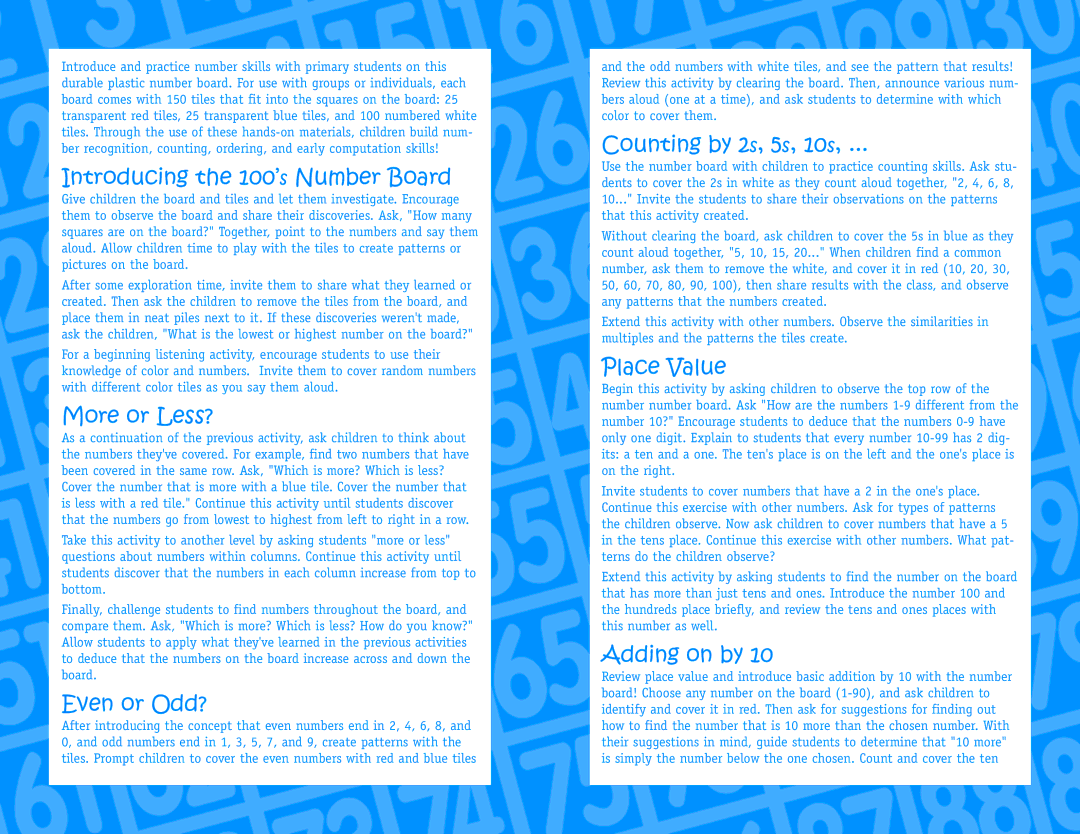
Introduce and practice number skills with primary students on this durable plastic number board. For use with groups or individuals, each board comes with 150 tiles that fit into the squares on the board: 25 transparent red tiles, 25 transparent blue tiles, and 100 numbered white tiles. Through the use of these
Introducing the 100’s Number Board
Give children the board and tiles and let them investigate. Encourage them to observe the board and share their discoveries. Ask, "How many squares are on the board?" Together, point to the numbers and say them aloud. Allow children time to play with the tiles to create patterns or pictures on the board.
After some exploration time, invite them to share what they learned or created. Then ask the children to remove the tiles from the board, and place them in neat piles next to it. If these discoveries weren't made, ask the children, "What is the lowest or highest number on the board?"
For a beginning listening activity, encourage students to use their knowledge of color and numbers. Invite them to cover random numbers with different color tiles as you say them aloud.
More or Less?
As a continuation of the previous activity, ask children to think about the numbers they've covered. For example, find two numbers that have been covered in the same row. Ask, "Which is more? Which is less?
Cover the number that is more with a blue tile. Cover the number that is less with a red tile." Continue this activity until students discover that the numbers go from lowest to highest from left to right in a row.
Take this activity to another level by asking students "more or less" questions about numbers within columns. Continue this activity until students discover that the numbers in each column increase from top to bottom.
Finally, challenge students to find numbers throughout the board, and compare them. Ask, "Which is more? Which is less? How do you know?" Allow students to apply what they've learned in the previous activities to deduce that the numbers on the board increase across and down the board.
Even or Odd?
After introducing the concept that even numbers end in 2, 4, 6, 8, and 0, and odd numbers end in 1, 3, 5, 7, and 9, create patterns with the tiles. Prompt children to cover the even numbers with red and blue tiles
and the odd numbers with white tiles, and see the pattern that results! Review this activity by clearing the board. Then, announce various num- bers aloud (one at a time), and ask students to determine with which color to cover them.
Counting by 2s, 5s, 10s, ...
Use the number board with children to practice counting skills. Ask stu- dents to cover the 2s in white as they count aloud together, "2, 4, 6, 8, 10..." Invite the students to share their observations on the patterns that this activity created.
Without clearing the board, ask children to cover the 5s in blue as they count aloud together, "5, 10, 15, 20..." When children find a common number, ask them to remove the white, and cover it in red (10, 20, 30, 50, 60, 70, 80, 90, 100), then share results with the class, and observe any patterns that the numbers created.
Extend this activity with other numbers. Observe the similarities in multiples and the patterns the tiles create.
Place Value
Begin this activity by asking children to observe the top row of the number number board. Ask "How are the numbers
Invite students to cover numbers that have a 2 in the one's place. Continue this exercise with other numbers. Ask for types of patterns the children observe. Now ask children to cover numbers that have a 5 in the tens place. Continue this exercise with other numbers. What pat- terns do the children observe?
Extend this activity by asking students to find the number on the board that has more than just tens and ones. Introduce the number 100 and the hundreds place briefly, and review the tens and ones places with this number as well.
Adding on by 10
Review place value and introduce basic addition by 10 with the number board! Choose any number on the board
